This was published 5 years ago
Aalborg, Denmark: How the home town of Sydney Opera House architect JørnUtzon became a design destination
By Helen Pitt
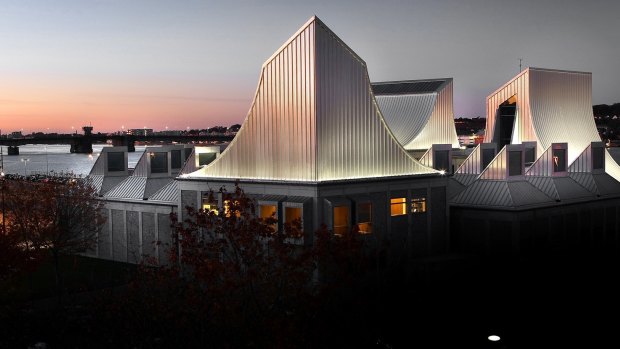
Utzon Center Aalborg.Credit: Utzon Centre
It's hard to say what Danish architect Jørn Utzon would have thought about the sails of his trademark building, the Sydney Opera House being lit up with advertising to promote the Everest horse race at Randwick. He's been dead for a decade, and his dramatic departure from Sydney in 1966 following a dispute with a previous NSW Liberal government, indicates he'd unlikely be overly happy. But the man was a maverick so who knows?
To get a better understanding of the architect born a century ago this year, it's best to go back to his childhood home, in the then industrial port town of Aalborg. As a newborn his parents moved him and his elder brother Leif to this northern Danish, where his father Aage had a job in the shipyards as a naval engineer. It was here on the Limfjord, the waterway that cuts his childhood home town in half, that the Danish architect's love affair with sailing boats and building beautiful things began. Any pilgrimage to the homeland of the Pritzker Award-winning designer must include this city 400 kilometres north of Copenhagen.
Long ago, the Limfjord was a highway for Viking longboats that teemed with eels (its name means eel castle). When the Utzons arrived in 1918, it was an industrial hub with its deep port dominated by the naval shipyards, the herring fishing industry, the Dansk Sprit factory (makers of that Scandinavian alcoholic staple, aquavit) and the Obels Tobacco factory.
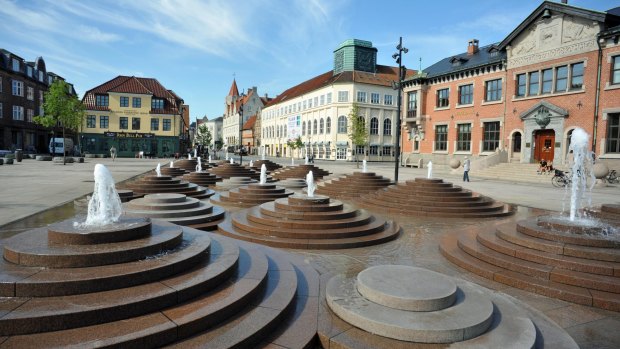
Aalborg is a Danish design destination.Credit: Shutterstock
The shipyards, the tobacco and aquavit factories that once made this city famous have long closed. Now Jørn Utzon, the city's most loved son, makes this place famous; transforming it into a Danish design destination. The recently renovated waterfront where the Utzon brothers used to sail from as Sea Scouts, is now home to a host of outstanding examples of modernist architecture.
There is the House of Music (Musikkens Hus) known as the new architectural lighthouse of Aalborg and home to the city's symphony, the Jutlandic Academy of Music and the Centre of Danish Jazz History. And Nordkraft, the city's former coal-fired power station that now generates a completely different kind of energy as a cultural and activity centre.
But it is the Utzon Centre, the last building Jørn designed with his son Kim, that first put this city on the international "designer tourist" map. It opened on April 9, 2008, Utzon's 90th birthday, he died later that year on November 29. The building's tall, dramatically curved sculptural roof, shaped slightly like a ship's hull (sound familiar Sydneysiders?) is a standout on the revitalised waterfront. It is home to an exhibition space (where earlier this year Denmark's Crown Prince Frederik opened Horisont, a retrospective on Utzon's architecture, now on display in Sydney until October 28), a harbourside eatery (Restaurant Jørn), an auditorium and a boat-hall. Before Jørn's birth, his father Aage was already a renowned wooden boat builder. But in 1929, when Jørn was 11, his father designed the "Aalborg dinghy", which became the standard boat for Sea Scouts across Scandinavia. He became known in the boat building world beyond Aalborg thanks to his dinghy design, and it was soon in demand from racing sailors across Europe as well as the US.
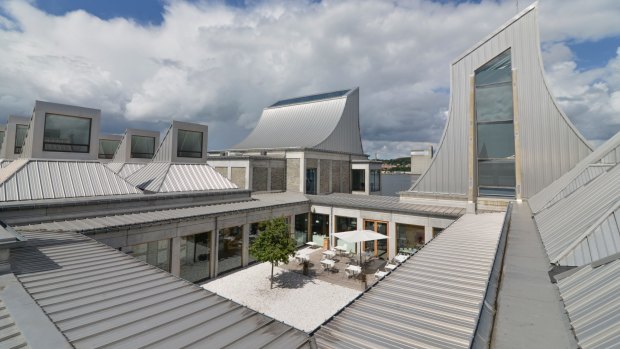
Utzon Center Aalborg.Credit: Utzon Centre
About 600 to 700 dinghies were built according to his specifications around the world. The permanent exhibition at the Utzon Centre contains a spidsgatter, one of the beautiful sharp-sterned boats Utzon senior designed. It is named Susi, and sits in the centre along with another Danish invention of note from Jutland: tubs full of Lego for design enthusiasts of all ages. The centre is not only Utzon's final work, but a homage to his father and his seafaring roots.
The mayor of Aalborg, Thomas Kastrup-Larson knows Utzon, who he calls the most important Danish architect in history, is the reason many come to this city. It is the hub of the centenary celebrations for Utzon's birth hosting architectural talks and other events including in December a performance by the Sydney Symphony Orchestra at the House of Music (Musikkens Hus). "Our old industrial city is now a young knowledge base city where culture is flourishing," he says.
The city's museum of contemporary art, Kunsten, designed in 1972 by the famous Finnish architect Alvar Aalto, has long been a drawcard to the city too. There's a lovely cobble-stoned old town, but the city's main attraction is its revitalised waterfront. Artists were invited by city hall to paint the silos, in a major work that honours the city's industrial beginnings. Even in winter, but especially in the long spring and summer nights, it is popular with walkers, joggers, musicians and basketballers. It is easy to see why the people in Aalborg, called Aalborgensere, were elected "the happiest people in Europe" in 2016 by the European Commission.
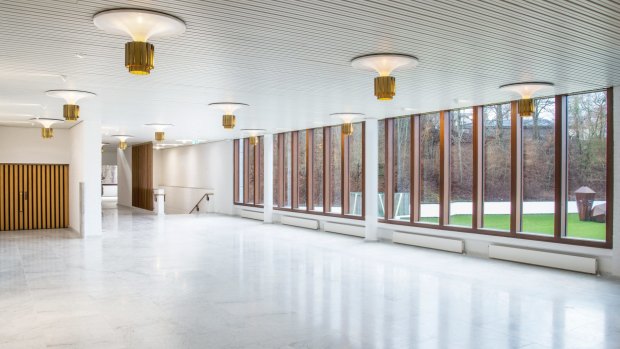
Foyer, Kunsten Museum of Modern Art.Credit: Niels Fabaek
It is also considered one of the "greenest cities in Europe", since industry disappeared from the city centre the water quality improved. Not only does the waterfront teem with life the water does, too. Instead of eels, as it was in Viking days, the water now teems with jellyfish – both the vandmand (blue moon jellyfish) and the brandmand (the red firefighter jellyfish). The waterway hosts cruise ships and an annual tall ships race rather than naval ships that were once built here. Sailing boats still ply the water as they did when the Utzon brothers were boys.
Utzon left Aalborg at the age of 19 when he enrolled in architecture at Copenhagen's Royal Academy school in 1937 and his father took a transfer to the shipyards at Helsingor, about 30 kilometres north of Copenhagen. It is here you will find Utzon's residential design known as the Kingo project: 63 affordable houses on four hectares of land on the outskirts of the the city. He had entered and won a competition in Sweden to build affordable homes there, but the project funding fell through. Instead he took his prize-winning plans to his local mayor in Helsingor who commissioned them.
The Kingo project showed off his love of Chinese courtyards – closed on the outside, but open to a central interior – just like the Aalborg Utzon Centre. When he won the international competition to design the Sydney Opera House in 1957, the Kingo project and his own home that he built to the north of Helsingor in 1952, were his major accomplishments. To keep his business afloat between competitions (he won several but none were funded) he designed lamps, notably the U336 pendant lamp, while he was working on his Sydney proposal.
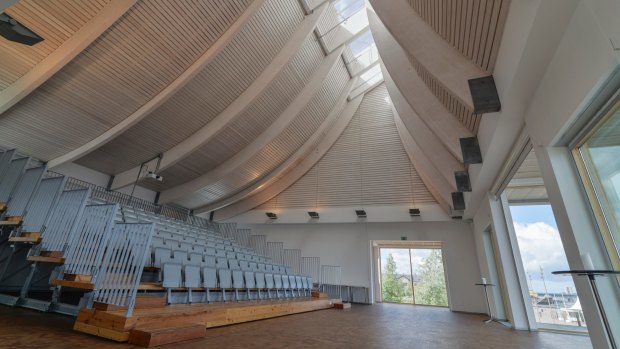
The Utzon Center Aalborg.Credit: Utzon Centre
In the six months he worked on it, to imagine the shape of the land at Sydney's Bennelong Point, he would often go to Helsingor's Kronborg Castle a few kilometres from his home. The 15th-century castle immortalised as Elsinore in William Shakespeare's Hamlet, sits on a promontory surrounded by sea. While walking around its ancient walls, he realised that the Sydney Opera House would be like Kronborg: viewed from all sides. He had often sailed around the Kronborg peninsula, viewing the castle from all angles. He realised that the Sydney Opera House could not have an ugly side; it needed to be beautiful from all angles. For Utzon aficianados, this is a must-see as it helps to understand how he imagined the setting of his white shells in Sydney.
On his first visit to Sydney in July/August 1957, Utzon upset the management at Tooth's Brewery, the makers of the popular Resch's beer known as Dinner Ale (DA). The NSW Cahill government had set up a public appeal to fund his building, and Utzon suggested that perhaps the Australian beer maker kick in to construction costs, just as Denmark's Carlsberg brewery devoted some of its profits to science and the arts via the Carlsberg Foundation. Since 1847, the Carlsberg's founding family, the Jacobsens have always been major arts benefactors in Denmark. Copenhagen's trademark Little Mermaid at Langelinie sculpted by Edvard Eriksen was donated by brewer Carl Jacobsen to the city of Copenhagen in 1913. A replica remains at the brewery today and the Glyptoteket, a Copenhagen art museum built around the personal collection of Carl Jacobsen, the son of the founder of the Carlsberg Breweries, remains today one of the city's most popular attractions. While Utzon's suggestion may have upset Tooth's management and shareholders, it wasn't for long as the state lotteries that funded the building of the Sydney Opera House, were established that year in November 1957.
When Utzon returned to Denmark after dramatically departing Australia before completing the Sydney Opera House in 1966, the controversy that dogged him made it difficult to find work in his homeland. The Danish Association of Architects made it clear to him that he would never get an official job in connection with the Danish government because it appeared as if he had "run away" from his duties in Sydney. With no work coming from his own government, he became reliant on foreign and private commissions.
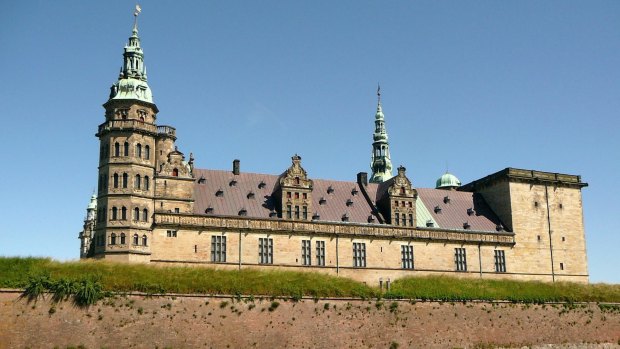
Kronborg Castle helped inspire Jorn Utzon's plans for the the Sydney Opera House.Credit: Shutterstock
Which is why you will find only a handful of Utzon works in Denmark. There were lesser-known works (such as his proposal, never built, for the Silkenborg Art Museum) an extension to the Louisiana Art Museum north of Copenhagen, a furniture store now Restaurant Paustian, in Nordhavn, Copenhagen's north harbour. But the Bagsværd Church in a northern suburb of Copenhagen, commissioned by a Lutheran parish is the piece de resistance. It is said to be the vision that most resembles his plans for the interiors of the Sydney Opera House. Its unassuming exterior is deceptive; the stark white interior with its curved ceilings, white besser blocks, and stage lights that come on when the congregation stands are a paean to modernism. For Utzon admirers this is holy ground. A visit here leaves you wondering the eternal Utzon question: what the interiors of the Sydney Opera House would have looked like, had he finished his masterpiece.
Helen Pitt is the author of The House, the dramatic story of the Sydney Opera House and the people who made it, published by Allen and Unwin on August 15.
TRIP NOTES
MORE
traveller.com.au/denmarkhttp://denmark.dk/
FLY
Qatar Airways operates several daily one-stop flights each week from Sydney and Melbourne to Copenhagen via Doha. For more information or to make a booking call Qatar on 1300 340600. Norwegian and KLM have several daily 45-minute flights from Copenhagen to Aalborg ranging in price from $50. The four to five-hour train trip from Copenhagen to Aalborg costs about $120 and can be booked at raileurope.com.au
EAT
Breakfast is the meal the Danes do best from fresh rye bread straight out of the oven, to cold collations and cheese with jam on top. For one of the best buffet breakfasts with a view of downtown Copenhagen try the design hotel next to the City Hall and near Tivoli: The Square, Copenhagen: thesquarecopenhagen.com/
Helen Pitt travelled at her own expense to Denmark, and was a guest of the Carlsberg Foundation in Copenhagen.
Sign up for the Traveller Deals newsletter
Get exclusive travel deals delivered straight to your inbox. Sign up now.